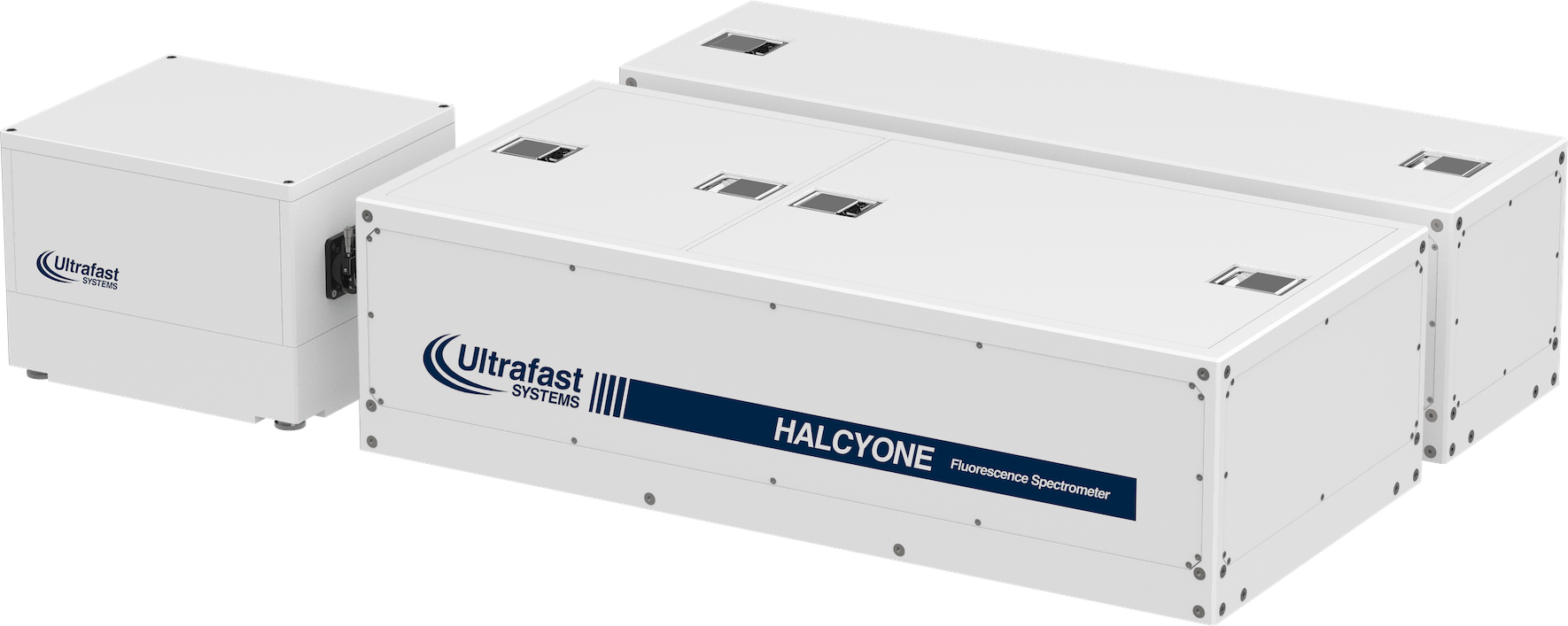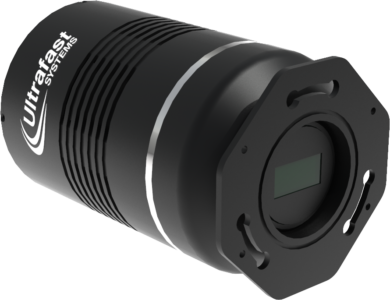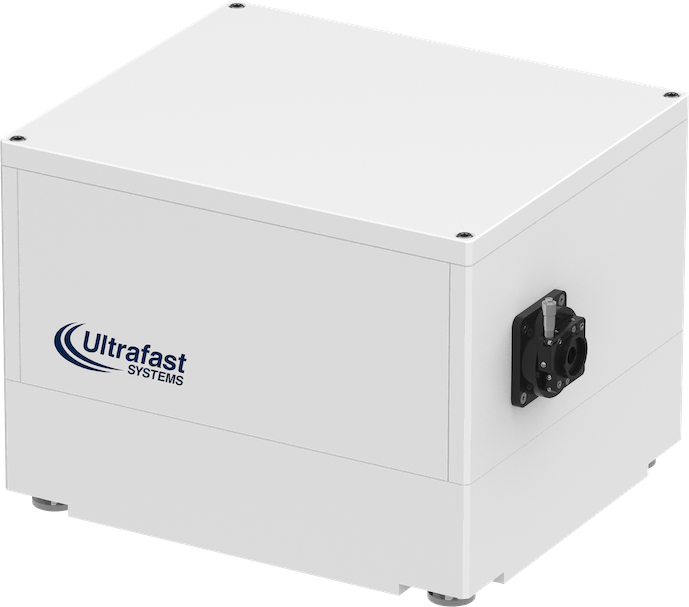
HALCYONE Femto is a fully automated Fluorescence Upconversion Spectrometer. It features our patented automated beam alignment system and can measure fluorescence decays with femtosecond time resolution over an 8 ns time window.
An exact fluorescence detection range depends on the laser wavelengths used for excitation and gating as the scattered laser light can interfere with the fluorescence signal. While the excitation wavelength is typically tuned to match the absorption of a specific chromophore, the gate wavelength normally corresponds to the fundamental output of the laser.
The residual excitation light after the sample can usually be blocked with an optical filter. However, the detection of the upconverted fluorescence signal is often obscured by the scattered gate and its harmonics leaking into the detector.
Therefore, for Ti:Sapphire lasers with the center wavelength of 800 nm detecting the fluorescence around 267 nm, 400 nm, and 800 nm is very difficult. It is similar for Yb lasers with the 1030 nm center wavelength – the fluorescence around 343 nm, 515 nm, and 1030 nm is hard to measure.
One way to mediate such spectral “blind spots” is to use an OPA for gate pulse generation.
Fluorescence can be measured across the following spectral ranges:
Spectral Range
With Ti:Sapphire laser (center λ ~800 nm)
With Yb laser (center λ ~1030 nm)
With optional gate OPA
UV
270 – 350 nm
260 – 340 nm
VIS
450 – 770 nm
370 – 950 nm
340 – 1000 nm
NIR
> 850 nm
> 1100 nm
An up to 8 ns time window is covered by using an optical delay line. Our delay line features a low GVD dielectric retroreflector for high optical throughput and a shorter IRF; a direct drive linear motor for fast scanning; as well as computer-controlled steering mirrors for true hands-off operation.
Halcyone Femto uses our proprietary intensified spectral imaging detector with an electronic gate for reduced ambient light sensitivity. It is thermoelectrically cooled and is sensitive down to single photons, which makes it ideal for up-conversion and Kerr gate measurements.
This detector is also capable of integrating multiple photons per pulse with excellent linearity, which is great for working with low kHz lasers.
The detector is capable of simultaneous multi-wavelength fluorescence detection at kHz frame rates.

We recommend this detector for all types of femtosecond fluorescence measurements. Combined with the Ultrafast Systems spectrograph, it provides a great signal-to-noise ratio when simultaneously monitoring the fluorescence spectral evolution as well as the kinetics at individual wavelengths. For example, energy transfer processes, solvation dynamics, vibrational relaxation, etc.
HALCYONE is available with two detector options: single wavelength PMT or multi-wavelength CCD.
At any time HALYCONE can be upgraded to include the other detector option to extend the capabilities of the instrument.

Single photon counting PMT
with a monochromator. This detector enables HALCYONE to measure a single wavelength fluorescence signal at a particular time delay. The fluorescence signal can be measured as a function of time or wavelength by scanning an optical delay line or a computer-controlled monochromator, respectively. To maximize the sensitivity at each fluorescence wavelength, the phase matching angle of a non-linear crystal angle is automatically adjusted by a computer-controlled rotation stage.This PMT is capable of detecting single photons and offers the highest sensitivity. However, it can register only one photon per laser pulse and therefore is most beneficial at higher rep rates (tens of kHz and above). We recommend this detector for experiments where only select kinetics or spectra need to be acquired (no full time-wavelength-intensity surface is needed), and a high rep rate laser is available.

Thermoelectrically cooled CCD camera
(1024×255 pixels) with a high throughput imaging spectrograph. While not quite as sensitive as a single photon counting PMT, this detector can capture a broad spectrum at once and also register multiple photons per pixel, per laser pulse, thus providing a large dynamic range even at lower rep rates (~1 kHz). We recommend this detector for experiments where it is necessary to monitor the fluorescence spectral evolution as well as resolve decays at individual wavelengths. For example, energy transfer processes, solvation dynamics, vibrational relaxation, etc.
To maximize the upconverted signal intensity the non-linear crystal needs to be rotated to a certain angle, depending on the fluorescence wavelength. HALCYONE automatically adjusts this angle during the experiment, so no input from the user is needed.
Halcyone utilizes an imaging monochromator, which was designed and optimized for time-resolved spectrometry.
This monochromator features high spectral resolution, as well as an astigmatism-corrected design, optimal for multipixel array detectors. With the dual exit ports, this instrument can be used as a spectrograph as well as a monochromator.
The monochromator’s design (300 mm, F#6) matches the optics in the rest of the setup and maximizes the overall spectrometer’s performance.

The monochromator features a 4-grating turret with kinematic mounts for optimal wavelength coverage, optical throughput, and spectral resolution.
The UV-enhanced Al coatings on the monochromator mirrors ensure high efficiency of fluorescence and upconverted signal collection.

Halcyone features versatile and user-friendly LabVIEW based software for instrument control and data acquisition. The software allows for full experiment automation, so no input from the user is required for the whole experiment duration.
Supports PMT and intensified spectral imaging multichannel detectors with a computer-controlled monochromator.
Supports a CCD detector with a high throughput spectrograph.
Takes into account the pump and fluorescence wavelengths and automatically adjusts the computer-controlled non-linear crystal’s angle.
Automated alignment of the optical delay line.
Computer-controlled switching between UV, VIS, and NIR fluorescence spectral ranges.
Supports computer-controlled translating sample holder.
Supports pump beam shutter.
Supports motorized filter wheel for automated pump intensity control.
Saves every individual kinetic scan, so if the experiment is aborted (due to laser fluctuations, power outages, etc.) all previous scans are not lost.
Threshold adjusted automatic probe intensity spike rejection – an advanced setting that collects data points again if the probe is not stable.
API (Application Programming Interface) for HALCYONE is provided for further experiment customization and integration with external applications.
Time-resolved fluorescence spectrometers are designed to measure the lifetime of the emissive excited state of a molecule. As a result of the photon absorption, the molecule passes from the ground state to an excited state. The reverse transition will occur at a rate specific to this chromophore. The lifetime of fluorescence is unique for each molecule and depends on the molecule’s environment. This property makes time-resolved spectrometry a powerful tool for studying processes that may involve:
Radiative relaxation (fluorescence)
Vibrational relaxation
Internal conversion
Energy transfer
Intersystem crossing (i.e. singlet to triplet transition)
Solvation
Conformational changes
Electron transfer to another molecule or the solvent
In a broader sense, HALCYONE can be used in:
Photophysics
Cell biology
Photochemistry
Materials science
Photobiology
Nanoscience
This site is protected by reCAPTCHA and the Google Privacy Policy and Terms of Service apply.
© 2002 – 2024 Ultrafast Systems, 8330 Consumer Ct, Sarasota, FL 34240, USA. All Rights Reserved.
An answer to your question might already be there.